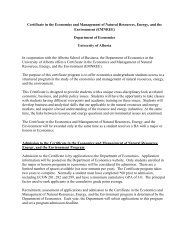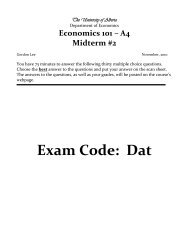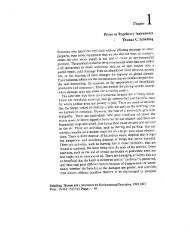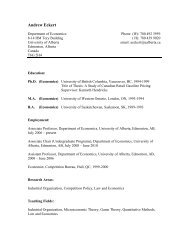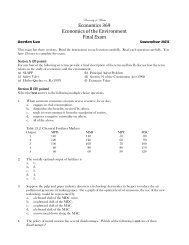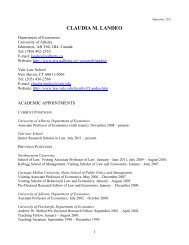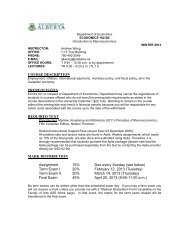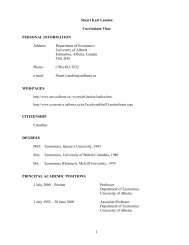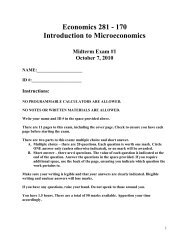(,()MMI'N r ON U.I\RK AND CARLSON 93reSOurce.When I pUlchase a piece of land, its price is a relleclion of the presentdiscounted value of its fullire henefit stream. By purchasmg the land. I am reallypurehasing the henefit stream-Ihul is, my property, the Ihmg I actually own.I..,11d is called IHoperly in everyday usage, but the essence of property IS the.' [ I 3 72 73 1henefit stream that I now own and that the slate agrees to protect . I . - . _. .Therein lies the source of confusion going back to the paper by Gordon. Whenec) ( nomists Ihink of property they may be inclined to think of an . object, and whenl ' h ' I dthey think of common property they think of joint use of that object. . IS ea s t?the uncrilical acceptance of the aphorism that "everybody's property IS nohodY.sproperty." In fact, it is correcl to say.only that "everybody s access IS nubody ~property." It is nuw well recogmzed m the hte.rature th~t a commol! pr~perl)f( '\ IJllrce is one <strong>for</strong> which the group of co-owners ISwell defined . . and <strong>for</strong> whIch [ the 5 7t ,.owners have established a management regime <strong>for</strong> determining use rates ~ - ,':I, 17). <strong>Common</strong> property is a management regime that closely resembles pm'ale2properr)' <strong>for</strong> a group of co-owners. Gordon and Demsetz certainly overlooked IhlS,and the confusion persists.' For instance, Clark and Carlson tell us that:pruperty resources include ope/l Q(H~SSIn ~(neral. the thcorcti(al characteristics of commonwith nonexistent. iII-delined. or unen<strong>for</strong>ceahle properly rights over use of the resources.(p. 451(emphasis added IIn point of facl, Clark and Carlson are here providing a definition of opel! accessresources (res nullius). True common property is defined by proscnbed access <strong>for</strong>.,!I nonowners and well-defined righls and duties with respect \0 rates of use lorthe group of owners; about Ihis there can be no mystery. The European commonfields. the common <strong>for</strong>ests Oriaichj) in Japan. the common pastures In theHimalayas and the Andes. and the summer pastures in the SWISS Alps areexamples of common property resources that were (and still are) certainly not opento all <strong>for</strong> indiscriminate squandering. These are examples of common propertyresources. Despite the sweeping predictions of Demsetz and others, these commonproperty natural resources have been well managed <strong>for</strong> thousands of years. Theyare not mismanaged precisely because they are common property resources. It IS"pen access resources-what Demsetz calls "communal property" -that are prone10 mismanagement. Although tight and mutually exclusive categories tend toconceal important subtleties, I suggest four possible natural resource r~gimes. inTable \. These regimes are defined by the structure of rights and dUlles whichcharacterize individual domains of choice.'This may suggest Ihat the term "common properlY" is redundant. a posilion that I reject. To lalk ofmake decISIonsprivale property <strong>for</strong> the group may suggest (hal co.owners relain full autonomy 10.property regimes prevent J~stregarding, <strong>for</strong> instance. alienation of their share. However. many commonqulleIhis aspect of autonomy. Hence. on closer inspettion. private property <strong>for</strong> the group can he..tlfferenl from common property. It looks like privale property <strong>for</strong> the group because exclus"," 01nonowners is presenl. [Jut the internal decision rules may differ considerably among these Iwo properlyregimes.JThe (act that some common properly regimes do not work well. meaning that natural resourcedegradation occurs. does not obviate the conceptual validilY of common ~roperty. S~mc: commonproperty regimes work very well. while some indeed work badly. Bul the ISsue here IS the propercomprehension o( alternative property regimts. nol how a particular regime (unclloAs In a. speclfl.l'instance. I note that privcHe property regimes are never ciled as Ihe cause of resource degradation. It ISpari of our received wisdom and ideology thai private property is eHicient ("good") and therdore wh~nsoil erosion or de<strong>for</strong>eslation occurs nn private land the cause is 1101the (private) property regime. hut::uher the "inappropriate" time horizon of the owner. or "inappropriate" prices.State properlyPriv.lIe propCrlY<strong>Common</strong>NonpropertyproperlySOllrce. Bromley 141.TABLE IFour Typesof ResourceRegimesIndividuals have a duty 10 ohserve use/access rules determinc:d hy a conlwl.ling/managing agency; agencies have a riR}u to determine usc/access rulesIndividuals have a right to undertake socially acceplahle uses ;llId have a duty tnrehain horn socially unacceplable uses; nlhers
<strong>COMMENT</strong> ON CLARK AND CARLSON 95 96DANIELW. BROMLEYnullius (open access) and res communes (common property). However, it does not~ II w that the term common property resource has no useful analytical role Inr~s~urce economics. The terms recommended by. Randall, "nonexcludable" andnonn 'val ," "S p eak only to the physical and economic aspects of a particular natur~1. . .resource-exclusion is very expensive (or impossible), or rlva Iry IS absent up un tII,,,ngestion sets in. But describing natural resources by their .phY~lcal and economicatlributes is only part of the task. It is also necessary to retain within the disciplinecertain concepts defining how individuals and groups have decIded 10 Slruclllreinstitutional arrangements over t/rose natural resources..A natural resource may in physical terms, be capable of exclusIOn at moderatecos, t and its use may b~ rivalrous. Social conventions which choose not toundertake mechanisms <strong>for</strong> exclusion may evo~v.e. Indee d '1 tf'. an esse.ntla . aspec. 0resource economics is understanding the conditions that will lead 1I1dlvlduals androups to undertake ef<strong>for</strong>ts to redefine the management reg~me-mstllutlonal~rrangements, including property rights-pertinent to a ~arl1cular natural. rece. The ef<strong>for</strong>t in the 1970s to create exclusive economic zones was preciselysour. . .concerned with converting open access coastal hsh~rles mto st~te. property reurces.Exclusion was always possible, and at certam levels of hshmg ef<strong>for</strong>t the:source was clearly rivalrous, yet prior to these institutional changes the resourcemanagement regime was one of open access rather than state property. The samerocess can be observed when natural resources which were <strong>for</strong>merly open to all~ecome the exclusive managerial domain of a group of users-they then becomecommon property resources..By suggesting that nonexclusiveness and nonrivalry "represent vast Improvements,useful in all contexts and relevant <strong>for</strong> both goods and resources," Randallelevates the physical and economic attributes of a natural resource to an exclusiveanalytical position. While these attributes are necessary components of our understanding,they are not sufficient. In the absence of a concept related to theinstitutional arrangements people create with respect to natural r.esou.rces, .economicsis left without a way to describe a resource ~anageme.nt re~lme m which .agroup of co-owners has exclusive use and managenal authority. Smce property ISthe income stream from a valuable asset (whether "produced" or "natural") andsince a group of individuals constitute the owners of that income stream, clanty ISadded by recognizing that they own it in common; it is common property.Why these ideas are so difficult to accept remains a mystery. On se~on~ .thoughtit is no mystery at all. Economics celebrates the autonomy of the mdlvldual tomake atomistic decisions without the need to consult another agent; pnvateproperty is the institutional structure most compatible with economic theory.<strong>Common</strong> property regimes will usually require that c~-owners en.gage m consultationand seek approval <strong>for</strong> certain actions. Hence, an Important dl~e~slOn of somecommon property regimes is at odds with prevailing economIc Ideology andmodels.In closing, the economics literature is full of casual and incorrect refer~~ces tocommon property resources as if this were a universal and im~utable classlflcallon-almost as if the prevailing institutional <strong>for</strong>m were somehow mherent m a naluralresource. Never mind that in one place trees and fish and range <strong>for</strong>age arecontrolled and managed as private property, in another setting they are controlledand managed as slate property, in another setting they are controlled and managedas common property, and in other settings they are not controlled or managed atall but are instead ,used by anyone who so desires. I suggest that there is no suchthing as a common property resource-there are only common property regimesover certain natural resources in specific settings, and at particular times. That is,natural resources are controlled and managed as common property, or as stateproperty, or as private property. Or, and this is where confusion persists in theliterature, there are natural resources over which no property rights have beenrecognized. We call this latter group open access resources (res nullius).REFERENCESI. L. C. Becker, "<strong>Property</strong> Rights," Routledge & Keegan Paul, london ()977).2. F. Berkes (Ed.), "<strong>Common</strong> <strong>Property</strong> Resources: Ecology and Community-Based Sustainable Development,"Belhaven Press, london ()989).3. F. Berkes, D. Feeny, B. McCay, and J. M. Acheson, The benefils of the commons, Nature(London) 340,91-93 (July 13, 1989). .4. D, W. Bromley, <strong>Property</strong> relalions and economic developmenl: The other land re<strong>for</strong>m, WorldDel'elop. 17,867-877 (June 1989).5. D. W. Bromley, "Economic Interests and Inslitutions: The Conceplual Foundations of PublicPolicy," Blackwell, Ox<strong>for</strong>d ()989).6. D. W. Bromley and M. M. Cernea, "The Management of <strong>Common</strong> <strong>Property</strong> Natural Resources:Some Conceptual and Operational Fallacies," World Bank, Washington, DC (1989).7. S. Ciriacy-Wantrup and R. C. Bishop, <strong>Common</strong> property as a concept in natural resource policy,Nalur. ResourceJ., IS, 713-727(1975).8. J. S. Clark and G. A. Carlson, <strong>Testing</strong> <strong>for</strong> common <strong>versus</strong> private property: The case of pesticideresistance, J. Environ. Econom. Management 19,45-60 (1990).9. C. J. Dahlman, "The Open Field System and Beyond," Cambridge Univ. Press, Cambridge (980).10. P. S. Dasgupta and G. M. Heal, "Economic Theory and Exhaustible Resources," Cambridge Univ.Press, Cambridge (979).II. H. Demselz, Toward a theory of property rights, Amer. Econom. Rev. 57. 347-359 (1967).12. H. S. Gordon, The economic theory of a common property resource: The fishery, J. Polito Econom.62, 124-142 (1954).13. A. I. Hallowell, The nature and function of property as a social institution, J. Legal Polito Soc. 1.115-138 (1943).14. G. S. Hardin, The tragedy of Ihe commons, Science 162, 1243-1248 (1968).15. B. McCay and J. M. Acheson, "The Question of the <strong>Common</strong>s: The Culture and Ecology orCommunal Resources," Univ. of Arizona Press, Tucson (1987).16. M. McKean, Management of traditional common lands in Japan, in "<strong>Common</strong> Properly ResourceManagement," Nat. Acad. Press, Washington, DC (1986).17. National Academy of Sciences, "<strong>Common</strong> <strong>Property</strong> Resource Managemenl," Nat. Acad. Press,Washington, DC (1986).18. R. Netting, What alpine peasants have in common: Observalions on communal tenure in a Swissvillage, Human Ecology 4, 135-146 (1976).19. A. Randall, The problem of market failure, Natural. Resource J. 23, 131-148 (1983).20. C. F. Runge, <strong>Common</strong> propertyexternalities: Isolation, assurance, and resource deplelion in atraditional grazing context, Amer. J. Agr. Econom. 63,595-607 (1981).21. C. F. Runge, Inslilutions and the free rider: The assurance problem in colleclive aClion, J. Polito 46.154-181 (1984).22. J, Sax. Some thoughls on the decline of private property. Was/rinKlon La... ReI', 58. 481-496 (1983).23. R. Schlatter, "<strong>Private</strong> <strong>Property</strong>: The IIistory of an Idea," Allen & Unwin, London (1951).



